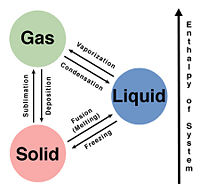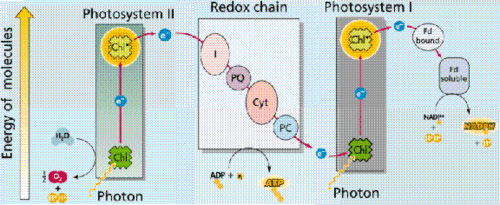Phase transitions in biological systems: Difference between revisions
NickDeguzman (talk | contribs) |
NickDeguzman (talk | contribs) |
||
| Line 24: | Line 24: | ||
<br> | <br> | ||
==Biological Thermodynamics== | ==Biological Thermodynamics== | ||
Biological Thermodynamics combines the laws of thermodynamics with biology in order to explain or possibly quantify changes in energy from reactions. | Biological Thermodynamics combines the laws of thermodynamics with biology in order to explain or possibly quantify changes in energy from reactions. Many organ systems within the human body, (if not all of them), require some energy in order to function. In a plant, photosynthesis converts sunlight to energy usable by the plant so that it may synthesize sugars out of carbon dioxide gas and water. There has to be some sort of method to quantify the energy required in these reactions. | ||
==Sources== | ==Sources== | ||
Revision as of 01:05, 16 April 2009
Phase transitions are present everywhere. Even within something as complex as the human body or plants, phase transitions are still present throughout processes which these systems use to survive.
The Human Body as a Biological System
Respiratory System
Oxygen gas
Digestive System
Breakdown of food for energy. ATP.
Circulatory System
Transportation
Nervous System
Various signaling pathways
Reproductive System
The fertilization of an egg by sperm is irreversible.
Plants as a Biological System
Photosynthesis
Biological Thermodynamics
Biological Thermodynamics combines the laws of thermodynamics with biology in order to explain or possibly quantify changes in energy from reactions. Many organ systems within the human body, (if not all of them), require some energy in order to function. In a plant, photosynthesis converts sunlight to energy usable by the plant so that it may synthesize sugars out of carbon dioxide gas and water. There has to be some sort of method to quantify the energy required in these reactions.
Sources
1. “Digestion”, 15APR09, <http://en.wikipedia.org/wiki/Digestion>
2. Fox, Stuart Ira, “Human Physiology”, 10th Edition, McGraw-Hill Companies, 2008
3. “MIT Department of Physics: Biophysics: Biological and Medicine”, 15APR09,< http://web.mit.edu/physics/research/areasofresearch/atomic_cm_plasma/biophysics/biophysics.html>
4. “Nervous system”, 15APR09, <http://en.wikipedia.org/wiki/Nervous_system>
5. “Phase Changes”, 15APR09, < http://hyperphysics.phy-astr.gsu.edu/hbase/thermo/phase.html>
6. “Phase transition”, 15APR09, <http://en.wikipedia.org/wiki/Phase_transition>
7. “Photosynthesis”, 15APR09, <http://www.emc.maricopa.edu/faculty/farabee/BIOBK/BioBookPS.html>
8. “Photosynthesis”, 15APR09, <http://en.wikipedia.org/wiki/Photosynthesis>
9. “Soft Condensed Matter: where physics meets biology”, 15APR09,< http://physicsworld.com/cws/article/print/169>
10. “Types of Photosynthesis”, <http://wc.pima.edu/~bfiero/tucsonecology/plants/plants_photosynthesis.htm>
11. "Biological Thermodynamics", <http://en.wikipedia.org/wiki/Biological_thermodynamics>


